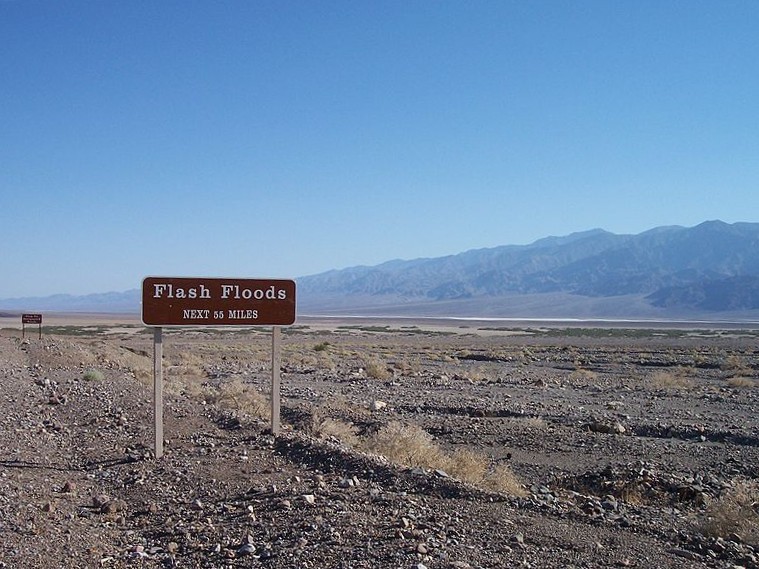I visited Death Valley in August 2008 shortly after rare and heavy rains (at least by Death Valley standards) turned one of the hottest and driest places on Earth into a riot of colors of yellow, blue, red and pink as wildflowers bloomed in the valley. The day I visited was bright and not at all unusual for Death Valley at this time of year. When at noon we tourists got off the air-conditioned bus, I felt like I had just stepped into a preheated oven. It was 112 degrees F.
I hadn’t thought about climate change that day. It was just the way Death Valley was and had been for a very long time. However, read on recent heavy rains in death valley twice in the past week—rains so heavy they trapped automobiles and closed roads due to mud and debris—I have taken note that in a place where drought and heat are normal, water has suddenly become a dangerous hazard, which has resulted in the closure of all roads in and out of the national park which includes Death Valley. (Something similar happened in Las Vegas, Nevada, the week before as water flooded streets and gushed from rooftops flooding casinos and scaring visitors. This in a city that receives less than 5 inches of rain per year.)
The drought received almost all the media coverage in the American Southwest. This is partly because the drought story persists over long periods of time and becomes a story whenever fear of water restrictions or actual restrictions surfaces or when it seems like the rain might bring relief.
The floods, however, come and go. But they participate just as much in the disruption and intensification of the hydrological cycle.
As predicted by climate models, the rains become more frequent and intense as the hydrological cycle accelerates due to greater evaporation resulting from warmer temperatures on Earth. Simply put, a warmer atmosphere can hold more water vapor, which means there is more rain available. But the odd result is that dry areas will tend to get drier while many wet areas may experience even more precipitation. This is a general expectation that varies with specific circumstances. And, of course, recently we can see how devastating rains in dry places NOT built to handle such a large amount of water can be.
These recent heavy rains will do little to relieve the mega-drought in the American Southwest. Some 22 years of below normal rainfall is difficult to reverse in a short period. I first covered this drought when it was in its 10th year. It seemed disastrous to me then, but didn’t seem to cause much concern among the people of Las Vegas at the time as my title, “The Show Must Go On,” indicated.
There’s a little more alarm now than mandatory reductions in the delivery of water from the Colorado River to states along its banks have occurred and must now be pursued. During that month, it will be announced how the new growing pain from the cuts will be distributed among those served by Colorado.
Death Valley is looking more and more like the future of the American Southwest, hotter, drier, and punctuated by occasional catastrophic rainfall that still fails to make much of the long drought.
Do those living within the drought boundaries generally understand the trajectory they are on? Does the outside world? It’s hard to answer the first question. But the second may be easier. In the 22nd year of drought, more people moved to Arizona than left. More people moved to Utah than left. Since 2019, Nevada was always attracting new people from all over the country. Only California has lost population in the past two years.
Why people move is a complex question to answer. Increasingly, I believe, one answer will be water, both for those who leave these states and for those who consider moving to these states but end up choosing to move elsewhere rather than take a chance on increasing water restrictions as the region’s mega-drought continues to bear low on its inhabitants.
Photo: Death Valley National Park. National Park Service sign warns of flash flooding over wide area (2004). By Draxfelton. Via Wikimedia Commons https://commons.wikimedia.org/wiki/File:Death_Valley_flash_flood_warning_sign.jpg




